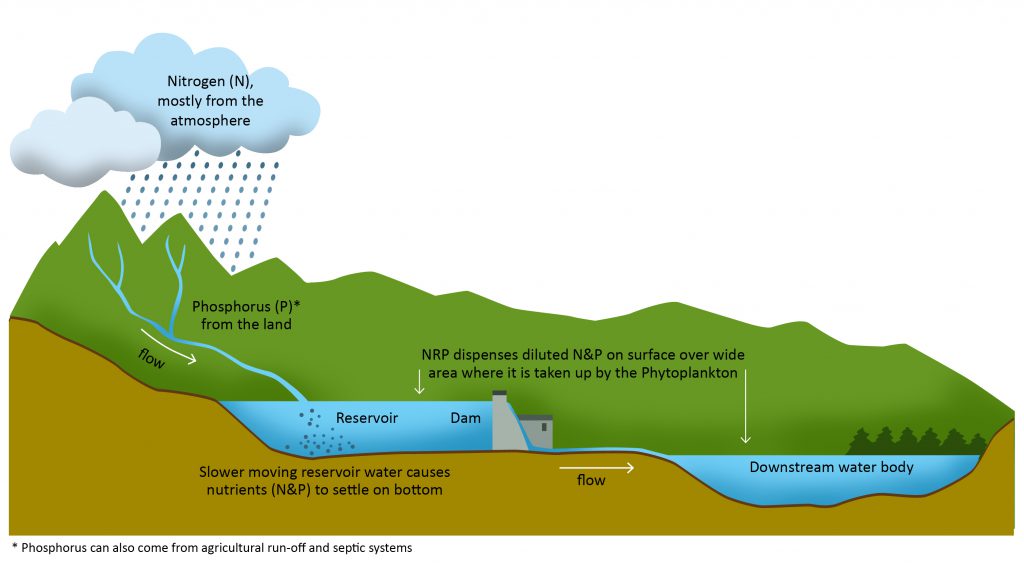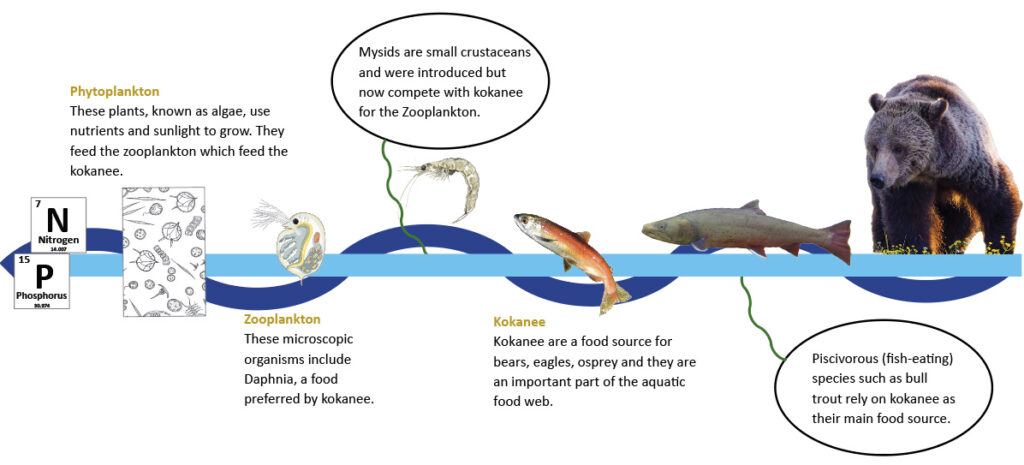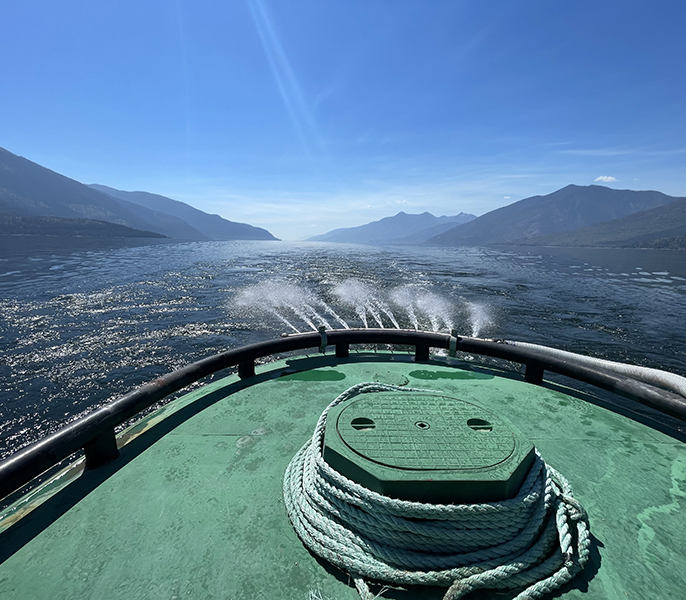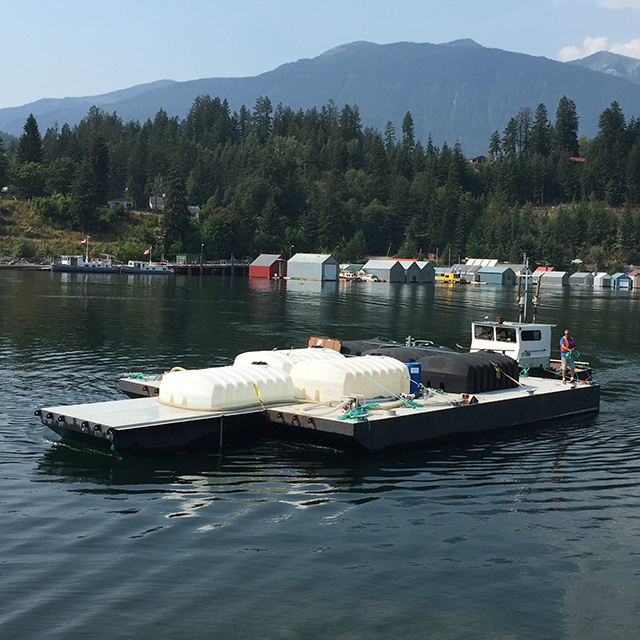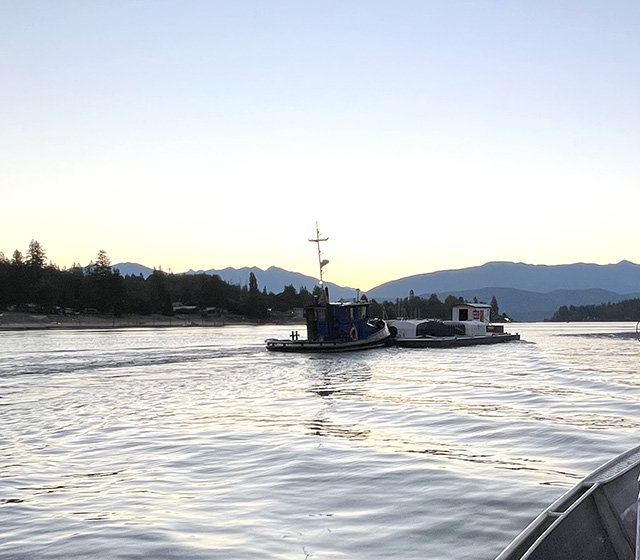Nutrient additions rebuild the natural food web
The Nutrient Restoration Program is rebuilding the natural aquatic food web that existed in Kootenay Lake and the Arrow Lakes Reservoir before the construction of BC Hydro dams. Since the 1990s, the Nutrient Restoration Program has been simulating the in-flows of nitrogen and phosphorus that would naturally occur during spring freshet.
Liquid nitrogen and phosphorus are added to both waterbodies. The nutrients feed the microscopic phytoplankton, which feed the zooplankton, which feed the kokanee and in turn the many other fish and wildlife that depend on this ecosystem. The nutrients are made up of phosphorus—agricultural grade ammonium polyphosphate (10-34-0)—and nitrogen—agricultural grade urea ammonium nitrate (28-0-0).
Nutrient additions are enhancing food web productivity
In 2022 an independent technical review of the Nutrient Restoration Program confirmed that the program is successfully restoring food webs in Kootenay Lake and the Arrow Lakes Reservoir to support fish populations.
The review recommends the program continue. Minor adjustments to the program were recommended, and were incorporated starting in 2023.
The review also found that:
- Since nutrient additions began, productivity at the bottom of the food web has increased by at least 50 to 100%
- Kokanee biomass (i.e., total weight of kokanee in the waterbody) has been on average about three times higher than before nutrient additions started
- If the Nutrient Restoration Program stopped, productivity could decline to pre-addition levels with consequences to the upper food web including kokanee
- The primary source of variability is annual weather and in-flows to the water bodies that influence growing conditions. In Kootenay Lake a -predator-prey imbalance has caused substantial variation throughout the food web
- The delivery of the Nutrient Restoration Program—the quantity of nutrients, the way they are added, and the source of the nutrients—is suitable.
Nutrients added from spring to fall
This experimental program started in 1992 in the North Arm of Kootenay Lake. In 1999, the program was expanded to Arrow Lakes Reservoir, and between 2004 and 2022 nutrient additions occurred in the South Arm of Kootenay Lake.
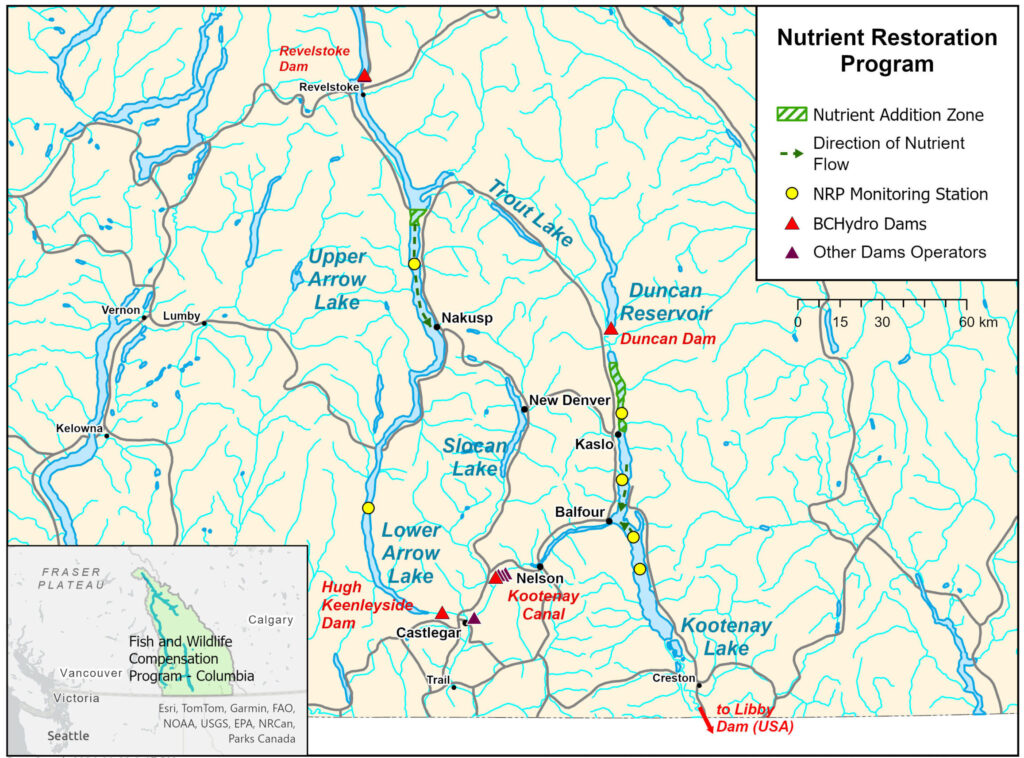
Nutrients are dispensed from spring to early fall and are seasonally adjusted to mimic natural loads. More phosphorus is added in the spring and, as the summer progresses, more nitrogen. In-season results also drive the amount of nutrients added to maintain the balance of nitrogen to phosphorus and grow the optimal size of phytoplankton which are key to supporting zooplankton, the food source for kokanee.
Nutrients are dispersed from a tugboat that is pushing a barge with tanks of nutrients on it on Kootenay Lake . Photo: All Too Clear
The nutrients are dispensed off the passenger ferry between Galena Bay and Shelter Bay. On Kootenay Lake, a tug and barge are used to dispense nutrients in the centre of the lake. Both methods work with the hydrology of each system to optimize nutrient distribution.
Monitoring helps balance a complex food web
Kootenay Lake and the Arrow Lakes Reservoir are large, cold, and naturally lower in nutrients than smaller, warmer water bodies. Careful monitoring of nutrients and fish populations is key to adapting the delivery of nutrients to meet the unique and complex variables of the food web.
Adding too many nutrients can lead to over-enriched bodies of water that produce too much or undesirable algae. As these algae die, they use oxygen to decompose, which is unhealthy for fish, plants, and other animals, and not all algae are edible to zooplankton.
Tug and barge operation: the liquid nutrients are stored in the tanks and then dispersed from the rear of the tug. Photo: Graham Marine
Annual delivery of the Nutrient Restoration Program is adapted based on results from monitoring stations in the North and South Arms of Kootenay Lake, and in the Upper and Lower Basins of the Arrow Lakes Reservoir.
Monitoring includes temperature, chemistry, phytoplankton, zooplankton, and the presence of mysids – which were originally introduced to feed the kokanee but now compete with kokanee for food. In-lake kokanee abundance is estimated through hydro-acoustic surveys and trawl sampling, and kokanee spawners are counted in various tributaries to both Kootenay and Arrow, and at the Hill Creek and Meadow Creek spawning channels. Bull trout redd counts are monitored on select tributaries to Kootenay and Arrow, and angler surveys are carried out on Arrow Lakes Reservoir.
Early morning departure of the tug and barge for the main lake, from its base near Balfour. Photo: All Too Clear
The Nutrient Restoration Program is a partnership
The Nutrient Restoration Program is an annual and ongoing project funded primarily by the FWCP’s Columbia Region. It is reviewed each year by the Columbia Region’s fish technical committee and board.
The Nutrient Restoration Program is delivered on behalf of the FWCP by the Province of B.C. through a long-term agreement with participation from the Ktunaxa Nation, Okanagan Nation Alliance and the Secwepemc Nation. The Province of B.C. is responsible for managing fish stocks.
Columbia Power funds approximately 25% of the costs in the Arrow Lakes Reservoir. In the North Arm of Kootenay Lake, BC Hydro funds approximately 17% and, in the South Arm, the Kootenai Tribe of Idaho has funded nutrient additions in the past and is currently funding some of the monitoring on Kootenay Lake.
FWCP funding for the Nutrient Restoration Program
| Year | Arrow Lakes Reservoir | North Arm, Kootenay Lake | Total |
| 2023 | $1,096,251 | $1,267,169 | $2,363,420 |
| 2022 | $1,045,993 | $1,213,123 | $2,259,116 |
| 2021 | $906,365 | $868,357 | $1,774,722 |
| 2020 | $749,736 | $903,001 | $1,652,737 |
| 2019 | $847,353 | $1,060,612 | $1,907,965 |
| Total | $4,645,698 | $5,312,262 | $9,957,960 |
The FWCP is a partnership between BC Hydro, the Province of B.C., Fisheries and Oceans Canada, First Nations, and public stakeholders to conserve and enhance fish and wildlife in watersheds impacted by BC Hydro dams. In the Columbia Region, the FWCP has a long-term agreement with the Province of B.C. to coordinate the Nutrient Restoration Program.
Info Session: Nutrient Restoration Program on Kootenay Lake and Arrow Lakes Reservoir
February 8, 2024
The base of an aquatic ecosystem is amazing, and essential for the food web in freshwater lakes and reservoirs. Come and learn about the restoration of two systems through the applications of nutrients. Hear about the microscopic plants and critters that keep these ecosystems thriving, and the animals they benefit. Marley will be talking about the history of the programs, how they work, and findings from a recent independent review of them.
Presenter: Marley Bassett, Fish Restoration Biologist, Ministry of Water, Land and Resource Stewardship



